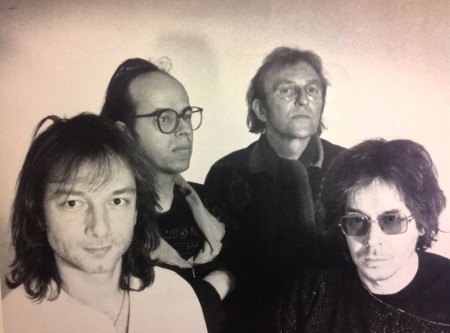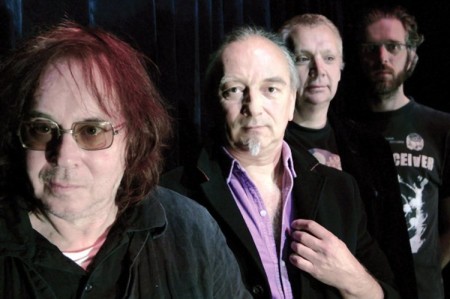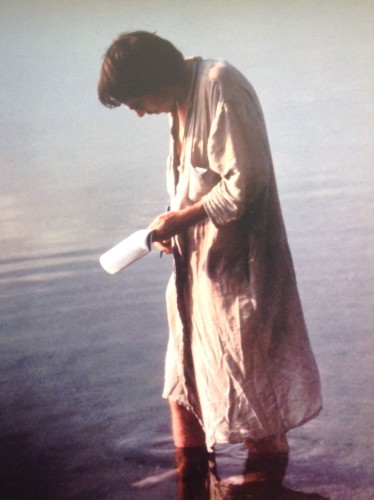
“The first music I loved was psychedelic… just always felt the need to push the brightly painted boat out further.” —Edward Ka-Spel (Above: photo by Inge Bekkers, courtesy Ka-Spel)
BY JONATHAN LEVITT
For the uninitiated, the Legendary Pink Dots create psychedelic songs that blend religion science and mythology into their own dense claustrophobic world.
As a band that has lived most of its life pitched on the edge of obscurity they have managed to assemble one of the most fiercely independent visions of music this side of Hawkwind.
The Maria Dimension, which came out in 1991 on Play It Again Sam (PIAS) and which celebrates 25 years since it was recorded, is as life altering a record as they come. Part cerebral science fiction part horror story, punctuated with a narcotic beauty, the record rotates like some rogue satellite spinning towards uncharted worlds.
It’s a record with a pulsing femoral tension that sucks you into its murky vortex.
To quote a review I once wrote about the album, “The Legendary Pink Dots album The Maria Dimension has as Bob Calvert of Hawkwind fame once said on his Captain Lockheed and the Starfighters, ‘A magnificent engine of steel and gleam’ at its core. I was blown away by this album back in 1991, and felt it was a masterpiece joyfully out of synch with the musical zeitgeist of the time. 25 years on, the music still sounds as unique and compelling as it did back then. That said, nothing could replace the memory of the first time I played this record on my college radio show. It felt like a sinister interception of a radio broadcast from another planet occupying a space where the Pain Teens are hanging with Syd Barret.”
I’ve come to a more recent conclusion about this album that what Edward Ka-Spel and crew have created here is something more subversive than I could have ever imagined back when the album came out. It’s more than just a tightly wound universe they’ve concocted, I’d say they were able to transcend the boundary between music and religion with this record. If you believe that music is its own language and that there are very real limitations to how we verbally describe things, then The Maria Dimension has created a aural vocabulary for communing with a much larger presence. It somehow has perfected the vocabulary for us mere mortals to transport us not merely out of our bodies but to suspend our own limited thinking allowing Ka-Spel and the Dots to bring us to a place where, as writer Ernest Holmes says,
“There is One Infinite Mind,
which of necessity includes all that is,
whether it be the intelligence in man,
the life in the animal,
or the invisible Presence which is God.”
I decided to contact Ka-Spel to talk about The Maria Dimension and where the “brightly painted boat” is currently moored. (Below: the band now)
BLURT: To start off where and when was The Maria Dimension recorded?
EDWARD KA-SPEL: All recordings took place in the barn next to the home of sax player Niels Van Hoorn on the border of Holland and Germany. We had an 8-track studio cobbled together and a stirring view of the great river Waal. The only hazard was the odd thunderstorm, which would mean a rapid dive for the mains switch to save everything from going up in flames.
Can you go into some detail as to how the sessions for the album went, something about the recording process and some of the unique instrumentation used and any special production techniques employed?
The album before Crushed Velvet Apocalypse had been very much composed beforehand by myself and Phil (The Silverman) in the flat we shared- so it was time to throw the gates of chance open. We literally improvised for a month with no restrictions. Two huge kettledrums were dusted off, Bob got the sitar out of the case, I dug out little stringed souvenirs, which I’d found in Greece and other exotic places. Bob recorded EVERYTHING on his cassette recorded which was placed in the middle of the room- it was necessary because half-inch tape was pricey. We re-worked much of it formally for the album itself. Mixing was eccentric. Engineer Hans left the band midway through recordings, so it was a case of 2 octopuses on a mixing desk with the captain barking from the back.
What is The Maria Dimension?
A place where multiple Marias sit serenely and wave to us as the snowflakes fall. It is not an earthly place.
Did this idea of a Maria Dimension already exist and lead to songs coalescing around that “unearthly place,” or did the idea come later?
It was there at the time.
Who designed the cover of the album? Why was the original art not used for some later editions of the album?
Stephan Barbery (house artist at Play It Again Sam records) painted the cover after I gave him the concept outlined above. I guess that in my head I had a real scene etched (it was actually a dream) which could never in fact be captured unless someone sneaked inside my mind with a camera. Still it is THE cover for MD; a later Polish release was simply part of an album series with covers designed by a single artist…
Who produced the record?
We all did.
PIAS as a label back in the late’ 80s early ‘90s seemed to have quite a unique roster of artists, what was there reaction when you first played them the album?
They were great. Really got behind it and it did surprisingly well for an obscure band like The Pink Dots.
How long had the songs on this album been floating around in one form or another?
“The Third Secret” had been there for maybe six months but most were recorded after being pulled fresh from the river outside.
Did you have a specific narrative arc for the sequencing of the album if so can you tell us what it was? If not what were some of the choices you remember making in terms of the running order?
It just seemed to flow naturally little discussion was needed.
Personally where do you place this record in terms of all of the Dots records?
Obviously very high up there considering the fact that we’ve just put out a 5-LP Box set containing all the sessions as well as the full album in its glory (the original vinyl edition was severely truncated as CDs were just becoming all the rage).
Do you feel this album gave the band a higher profile especially in the US given the amount of press the album received and how it was promoted to college radio?
It surely helped, although the successor Shadow Weaver fared better in the States.
In terms of live shows, have you ever played the entire album all the way through live for an audience?
No, we tend to dive in and out, pick and choose- but odd songs still crop up live today.
“Disturbance” is one of the finest songs you have ever recorded can you talk about how this song came into being?
Began as a concept to see how stacking guitar after guitar would sound. Phil provided the perfect “Slave ship rhythm”. We were very much into German bands of the ‘70s at this time.
In terms of musical influence that fed directly or indirectly into some of The Maria Dimension’s tracks you mention you were listening to ‘70s krautrock; any bands and albums in particular?
Nothing particular. The usual culprits like Ash Ra Tempel, can… but also early Chrome.
Speaking of 70’s German bands, have you ever wanted to do much longer Amon duul like numbers?
They do happen, but we trim them before they go out for public consumption.
Your music is part psychedelic mixed with an industrial vibe on some of the tracks, was this album a point in time where both began to coalesce as equally important musical directions the band could follow?
Categories never really mattered to us (still don’t)…The first music I loved was psychedelic….just always felt the need to push the brightly painted boat out further.
“Pennies for Heaven” is one hell of a creepy song with some unforgettable imagery—did the lyrics predate the music, or how did this song come to you?
The lyrics predated the song. One of those unpleasant dreams of a plane crash, which needed to be purged.
Speaking of lyrics and songwriting what is the process you went through for this record? Do you jam as a band or do you write on your own and bring in your ideas and the others help expand upon them?
A bit of both really…I do love a band improvising, even when it’s just myself and Phil rolling ideas to each other. Somehow that’s when the magic really happens.
What was touring during this period of time like for the band? Did US audiences get the music in a similar way to their European counterparts?
Very early days for touring in the US. In cities like SF and Seattle, awareness was high and the reception was sometimes ecstatic. But then there would be a bar in, say, Milwaukee where 20 people would be scratching their heads unless they’d driven there specially from Denver.
I met you at I believe at the (O’cayz Corral) or some other rock club in Madison Wisconsin, back in 1992-93 on your shadow weaver tour, so your comment about people in Milwaukee makes me laugh because attendance was pretty sparse. Does it take the wind out of your sails to play for a small audience or does it not matter?
I actually enjoy the contact when the audience is small…increases the one-on-one situations. Everybody smiling at some point.
What were some of the bands you played with on The Maria Dimension tour?
Ah, memory fails me….
Below: a live clip from 1991
Now I want to talk about the various editions of the record? Originally did the LP and CD differ in terms of running order and number of tracks?
Running order was the same, but the original LP sliced the recordings in half as vinyl was regarded as future landfill at that time. That’s why we have made this enormous luxurious vinyl box set this year.
What was The Maria Dimension 3”— what editions of the album came with this bonus? Then there was Chemical Playschool 8&9 —who got that record and could you tell us something about it?
The 3” was a marketing ploy of PIAS- we always have extra tracks in the can and they all came from these sessions. CP 8 & 9 is largely created out of reworkings of the Maria sessions.
I heard a bootleg titled The Maria Sessions, I’m aware bootleggers can label things whatever they want, but if the music is from those sessions, it hints at a very different sound for the band filled with long form abstract numbers part Pink Floyd part Harmonia, can you tell us about these tracks?
It’s not a bootleg. It’s a privately released CD-R which is part of the vinyl box set now. It’s actually created from Bob’s cassettes of the first improvisations.
How did those long form initial improvisations lead to the dense songs we hear on the record what was the evolutionary process?
Evolutionary process is a well-chosen term…you can hear the seeds of “Evolution” right there. But the mutations of seeds scattered in those improvs were radical.
You mention that you have a box set of all of the sessions for the album. How were these sessions scheduled, was this worked on for an intense period of time all in one go or would you tour and then come back to recording?
We played for a solid month then had a holiday break, then all resumed for another 4-6 weeks when we consolidated what we had, tried various concepts (Disturbance for example), and mixed.
In 1991 vinyl was making its original last stand: Were you involved in mastering for the LP? Were you satisfied with the how the record sounded?
I confess I never listened to the original vinyl edition- I was just too disappointed by the presentation.
Below: a clip of the Dots performing live in 2014
Given that you never listened to the original vinyl, what’s different about this vinyl version? Is it on heavier vinyl stock? Are there liner notes included?
Well, ALL the bonus tracks are there making it a double. Then there’s Maria Sessions volumes 1 & 2 , which is another double album, and the 3″ single plus a collage of out-takes for disc 5. Great quality too, all remastered and packaging to die for..
If people want to order the record what’s the best place to get it?
We have a few on our bandcamp page (legendarypinkdots1.bandcamp.com) and also through Soleilmoon (www.soleilmoon.com)
When you look back to 1990/91 and the resulting album, what comes to your mind?
Well, I miss Bob still. It was his last album with the Dots before he succumbed to lung cancer in 1992. A different life back then—3 of us sharing a small flat. All very much hand-to-mouth existence.
What are you listening to these days?
Still a lot of great new bands/artists out there… Even so, played an old chestnut last night — Church of Hawkwind no less….
Final question: what does 2015 hold for you and the band what are you working on these days?
Ha, in fact not so much changed except that we’re taking some time off the road to push the multi-colored boat out into the middle of the ocean. We feel like we hit a bit of a pinnacle last year with Chemical Playschool 16/18, although we duly paid our dues to the Goddess of Obscurity by making it available only on double CD-R.
But hell, that’s just how we are.
***






